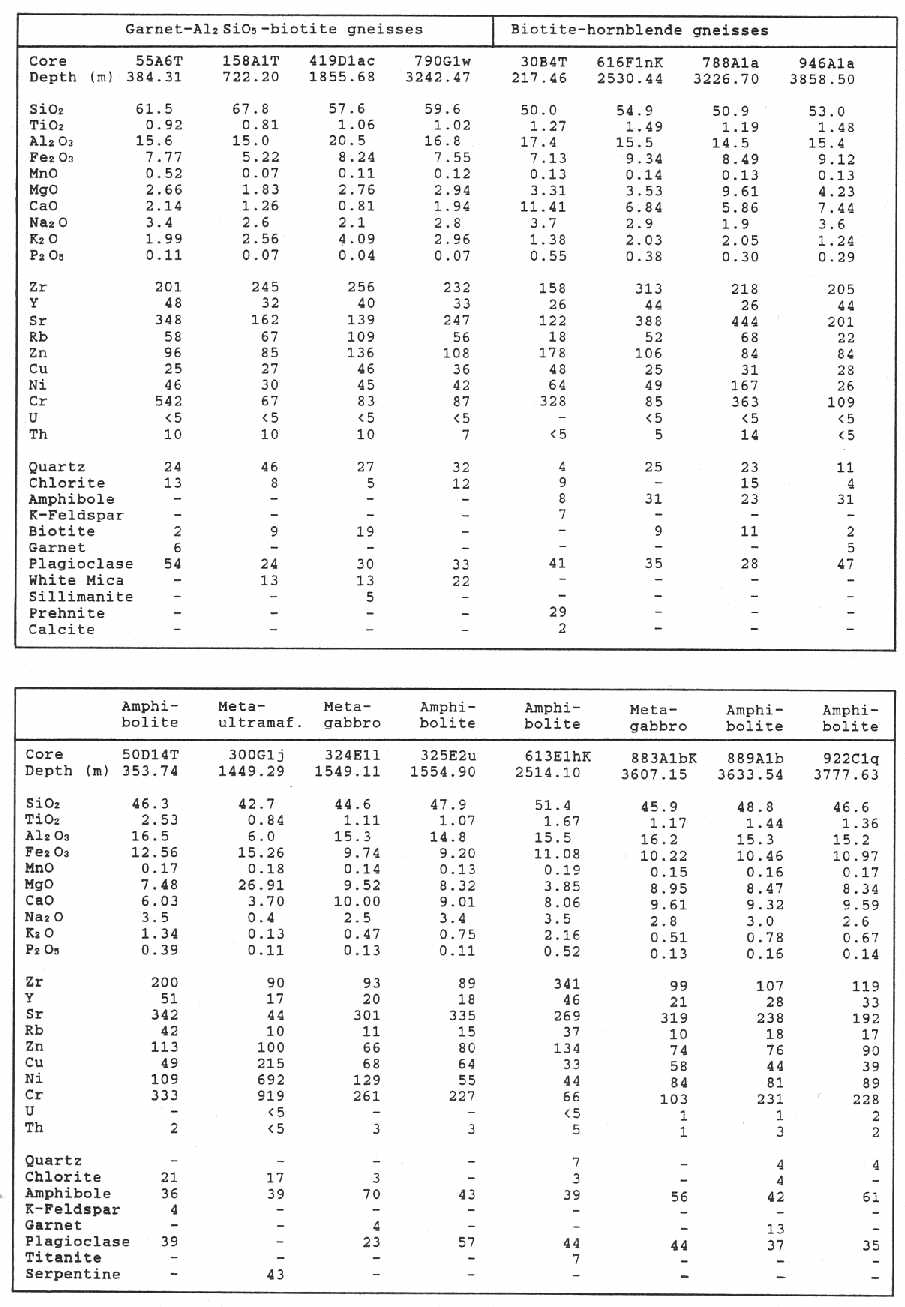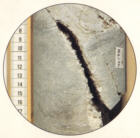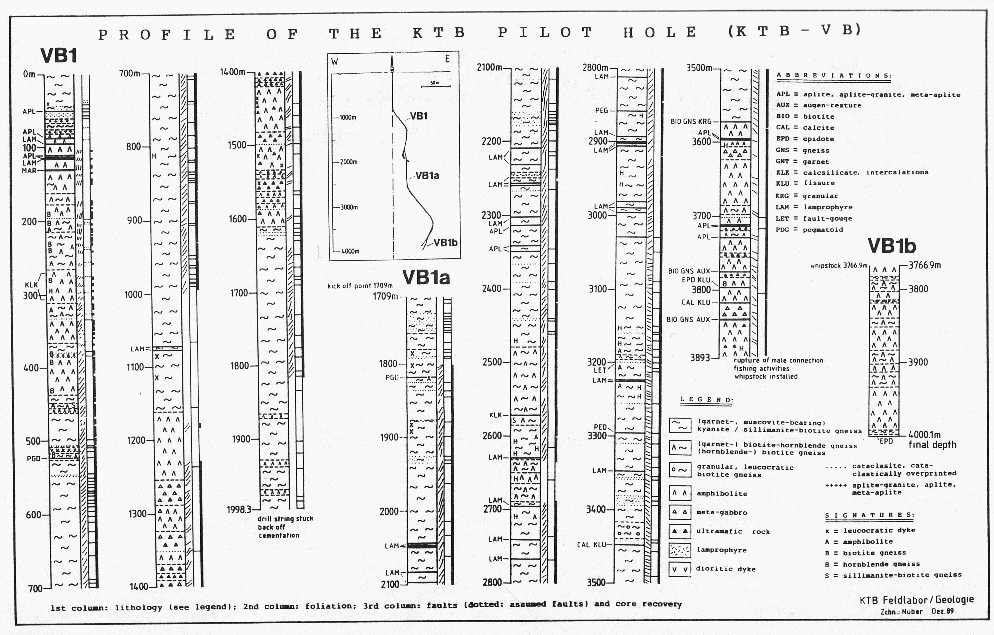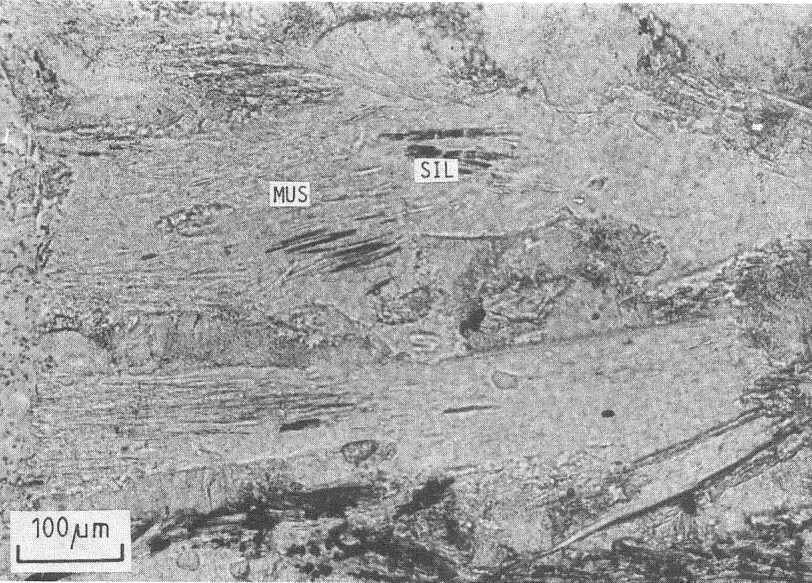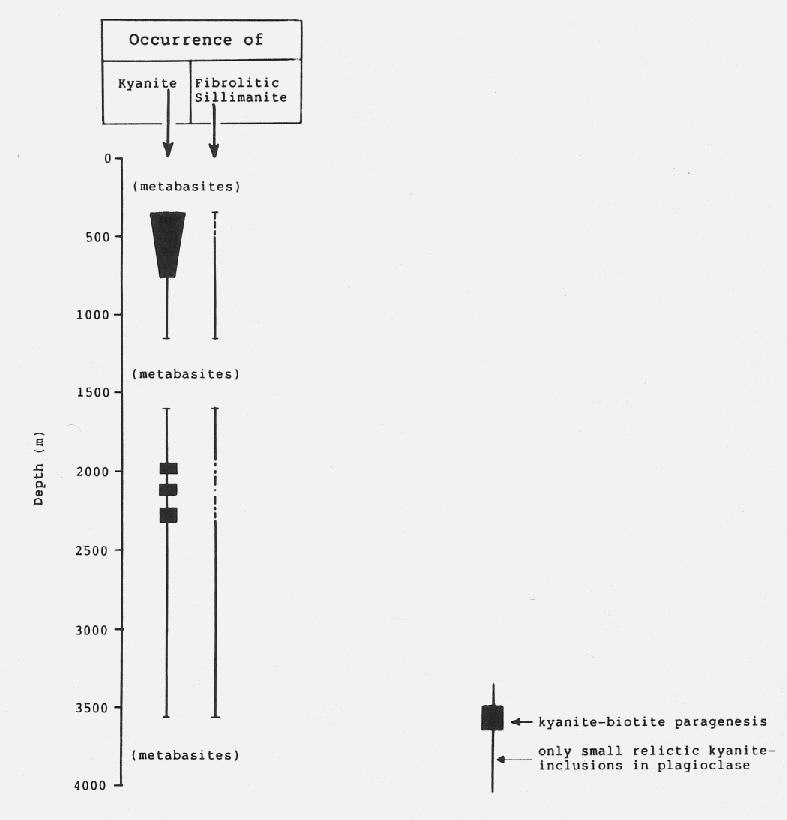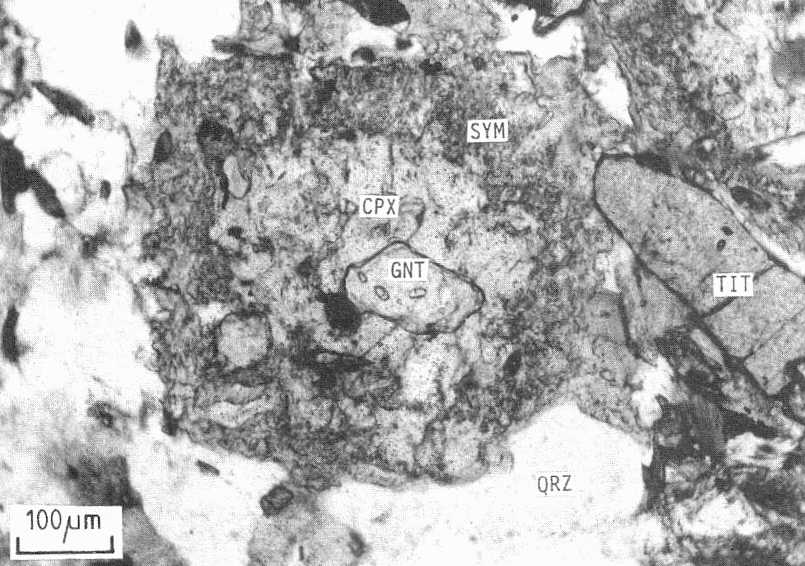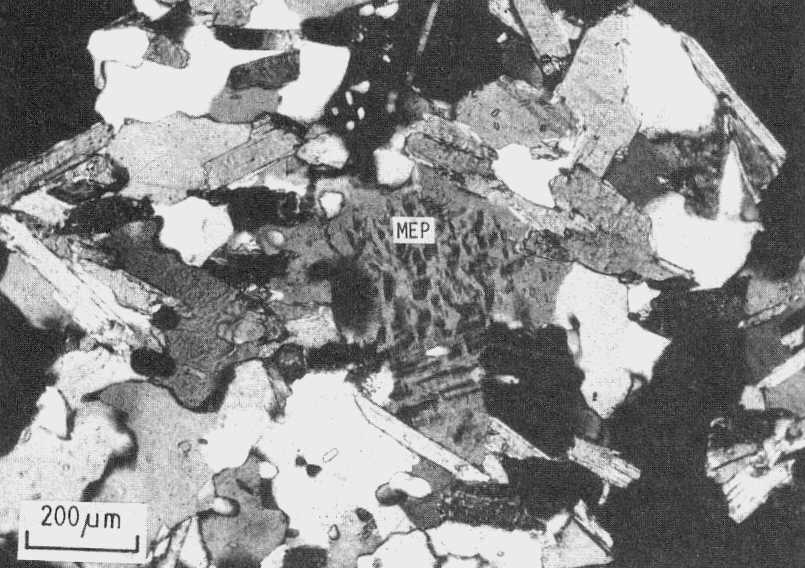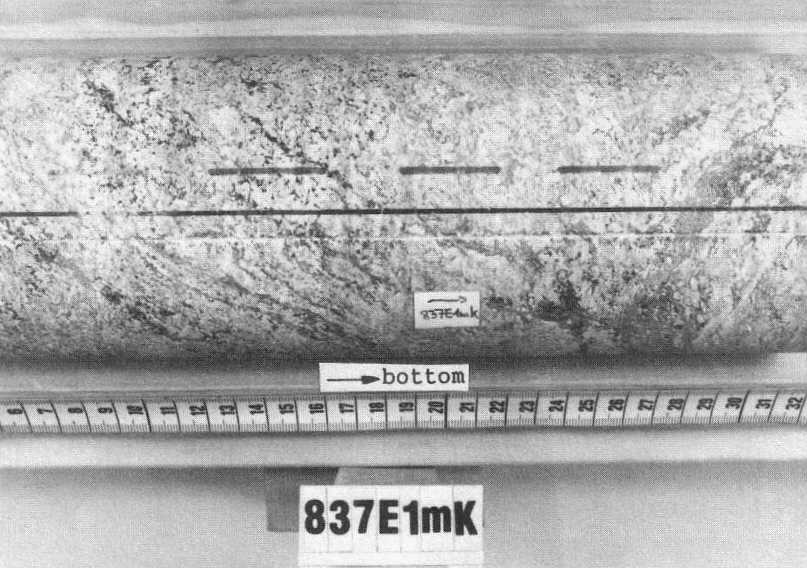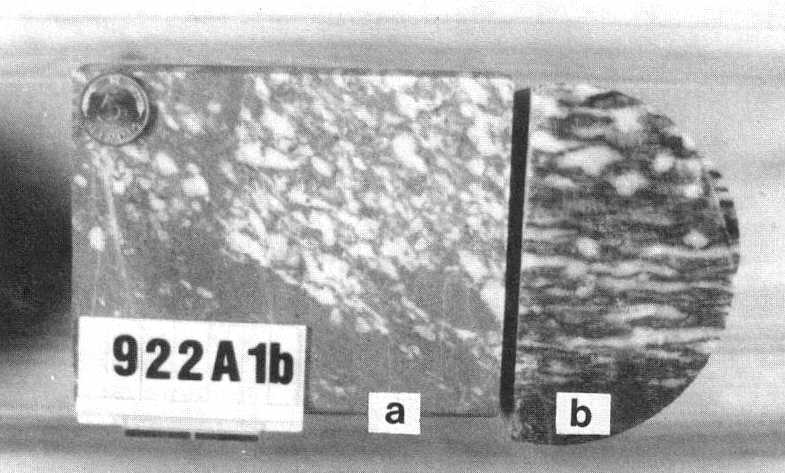B.2 Geological Section of the Pilot hole
Four characteristic rock series are alternating (Fig. B.2.1):
(1) 0 to 460 m: variegated sequence of garnet amphibolites with calcsilicate layers, muscovite-biotite gneisses, biotite-hornblende gneisses and minor marble.
(2) 460 to 1160 m, 1610 to 2470 m and 2690 to 3575 m: monotonous garnet-bearing biotite gneisses with kyanite and/or sillimanite. These gneisses, mainly with compositions corresponding to greywacke, were intruded by some lamprophyric dykes.
(3) 1160 to 1610 and 3575 to 4000 m: amphibolites, metagabbros and minor ultramafic rocks. The metabasites of basaltic composition show evidence of an early high-pressure metamorphism followed by the dominating amphibolite facies stage.
(4) 2470 to 2690 m: variegated sequence of biotite-hornblende gneisses with frequent interlayering of amphibolites, calcsilicate rocks and sillimanite gneisses. This sequence resembles (1).
Fig. B.2.1:Geological section of the KTB pilot hole.
(View enlarged geological section, 400 KB)
Down to a depth of 1200 m the foliation of the gneisses dips steeply towards SSW. From 1800 - 2500 m it is nearly vertical, switching between SSW and NNE dip direction. Between 2500 and 3150 m the foliation changes gradually into a shallower dipping or subhorizontal position. The dip direction varies between SW and E at 3050 - 3300 m (Fig. B.2.2). This variation of dip is bound to mesoscopic folds as well as to graphite-bearing fault zones. At the depth of 3050 to 3300 m folding and thrusting as well as normal faulting cause a complex structural pattern (Fig. B.2.3b). The structure at the depth of 3000 to 3500 m is considered as the hinge of a large open fold with subhorizontal axial plane. The axis plunges gently to SSE (Fig. B.2.3a).
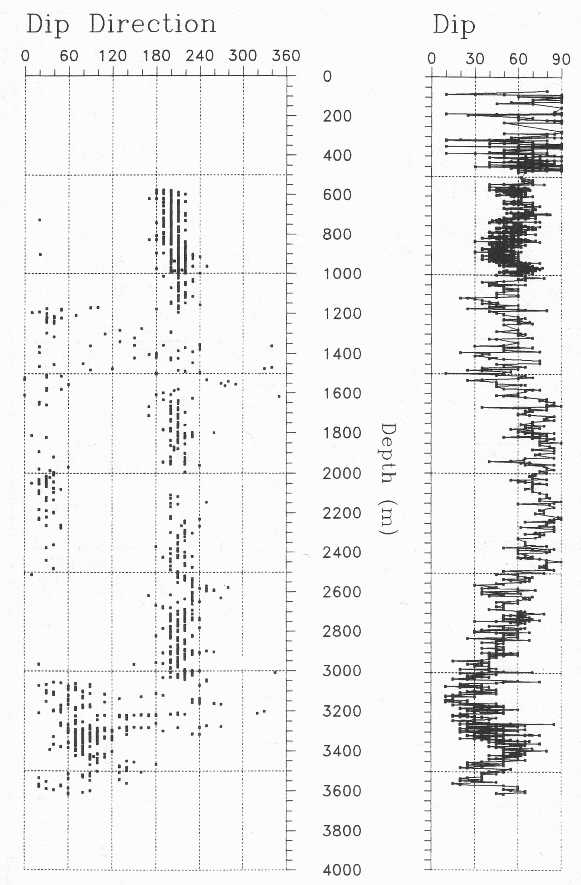
Fig. B.2.2: Dip and dip direction of the foliation.
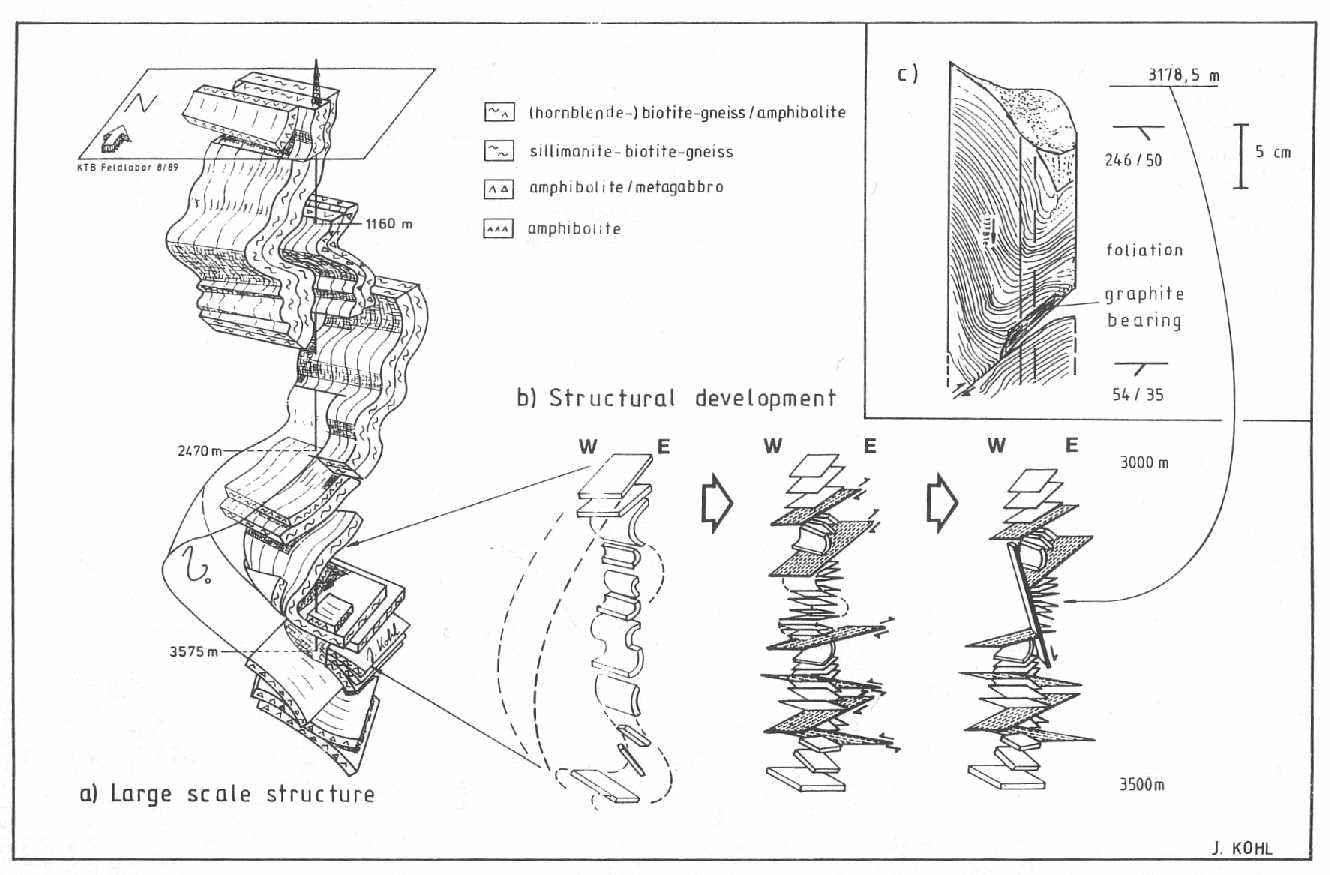
Fig. B.2.3: Schematic sketches of a) large scale structure, b) development of the interval 3000 - 3500 m during different stages of deformation and c) typical mesoscopic fold with reverse graphite-bearing fault.
The chlorite/(chlorite+biotite) ratio, applied as an alteration index, demonstrates the pervasive low-temperature alteration especially in the cataclastic zones 500 - 600 m and 1600 - 1800 m (Fig. B.2.4). The number of fractures per meter is generally decreasing with depth (Fig. B.2.5). The peak at 3580 m results from pronounced core disking at the lithological transition to the metabasites (cf. chapter G).
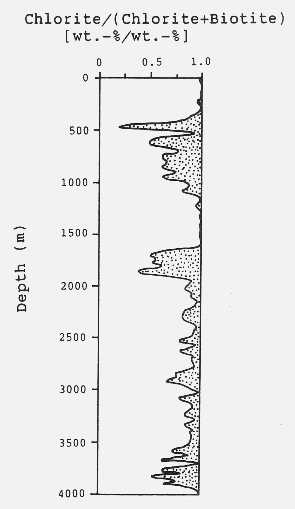
Fig. B.2.4: Plot of chlorite/(chlorite+biotite) versus depth. This parameter is used as an low-temperature alteration index. Chloritization of hornblende and garnet is subordinate and can be ignored (averaged data from quantitative XRD).
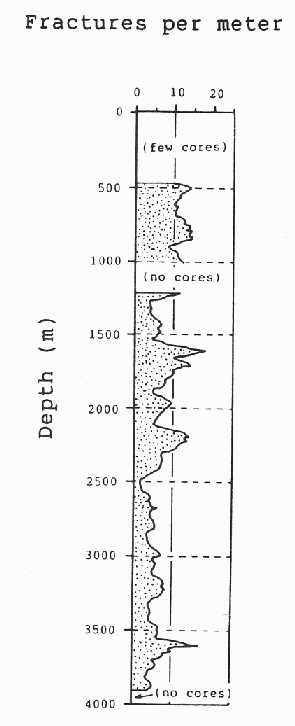
Fig. B.2.5: Averaged number of fractures per meter, measured at cores.
B.3 Gneisses
B.3.1 Petrography
Garnet-Al2SiO5-muscovite-biotite gneisses:
Garnet-Al2SiO5-muscovite-biotite gneisses form three monotonous series with minor intercalations of biotite-rich, amphibole-bearing gneisses and calcsilicate rocks. Fabrics vary from fine grained and finely layered to medium grained with flaser texture and layer to lense shaped quartz-feldspar-mobilisates (cf. chapter B.7 for a more detailed discussion of the different structural types). From 500 to 625 m and 950 to 960 m migmatitic phenomena are obvious.
Garnet and muscovite contents are variable. Muscovite has preferably grown in the vicinity of quartz-feldspar-mobilisates, in regions of intense retrogression and often around Al2SiO5-minerals (Fig. B.3.1). Garnet cores are often rich in inclusions of quartz, plagioclase or rutile, whereas the rims are free of inclusions. At least two types of garnet occur in the same thin section: large hypidiomorphic grains and smaller embayed ones (Fig. B.3.2).
Fig. B.3.1: Garnet-Al2SiO5-biotite gneiss. Relics
of sillimanite (SIL) within muscovite (MUS).
(Thin section CUT1006, 1006 m, // nicols).
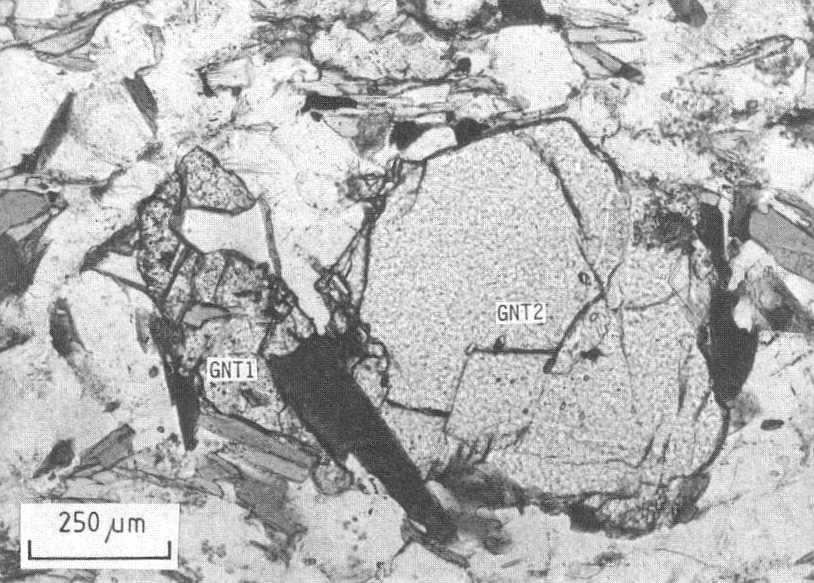
Fig. B.3.2: Garnet-kyanite-biotite gneiss with different garnet types: GNT
1 is small, embayed and rich in inclusions, whereas GNT 2 is roundish-subhedral
with inclusions in the core.
(Thin section 71A4T, 420.2 m, // nicols).
Al2SiO5-minerals are ubiquitous. Fig. B.3.3 shows the distribution of Al2SiO5-minerals with depth. Down to 750 m and in some layers around 2000 m kyanite is present in quite large amounts and is in contact to biotite. Kyanite forms single grains or grain clusters, where the individual grains display different crystallographic orientations (Fig. B.3.4 to B.3.6). In the other gneisses of appropriate composition kyanite occurs exclusively as minute rounded inclusions in plagioclase (Fig. B.3.7). Sillimanite was first observed in the garnet-muscovite-biotite gneisses at 450 m and becomes more prominent with increasing depth. It forms rare prismatic crystals and - more frequently - fibrolithic aggregates, in most cases intimately intergrown with biotite (Fig. B.3.8). Accessory minerals are zircon, monazite, tourmaline, and graphite. Apatite is occasionally accumulated in some layers.
Fig. B.3.3: Distribution of Al2SiO5-minerals in meta-greywackeceous and meta-pelitic gneisses.
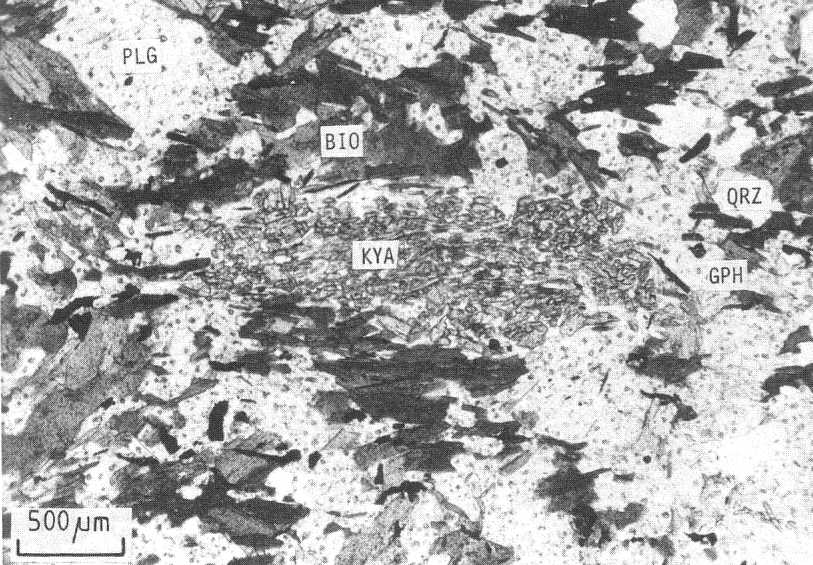
Fig. B.3.4: Graphite-bearing garnet-Al2SiO5-biotite
gneiss. Aggregate of disintegrated kyanite and small biotite and white mica
(KYA). QRZ = quartz, GPH = graphite, BIO = biotite, PLG = plagioclase.
(Thin section 53B7tII, 375.9 m, // nicols).
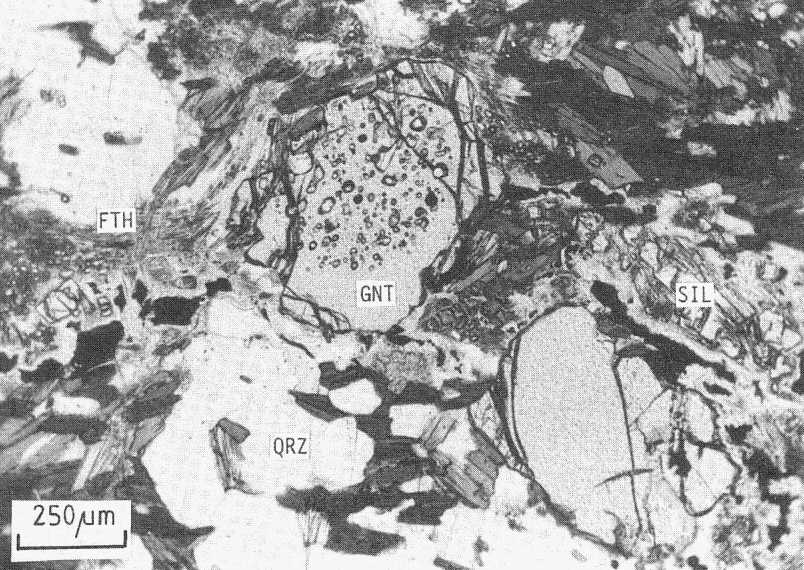
Fig. B.3.5: Garnet-Al2SiO5-biotite gneiss. Two types
of garnet, one with and the other without inclusions. QRZ = quartz, GNT =
garnet, SIL = sillimanite pseudomorphs after kyanite, FTH = fibrolithic sillimanite
(Thin section 97D3h, 546.8 m, // nicols).
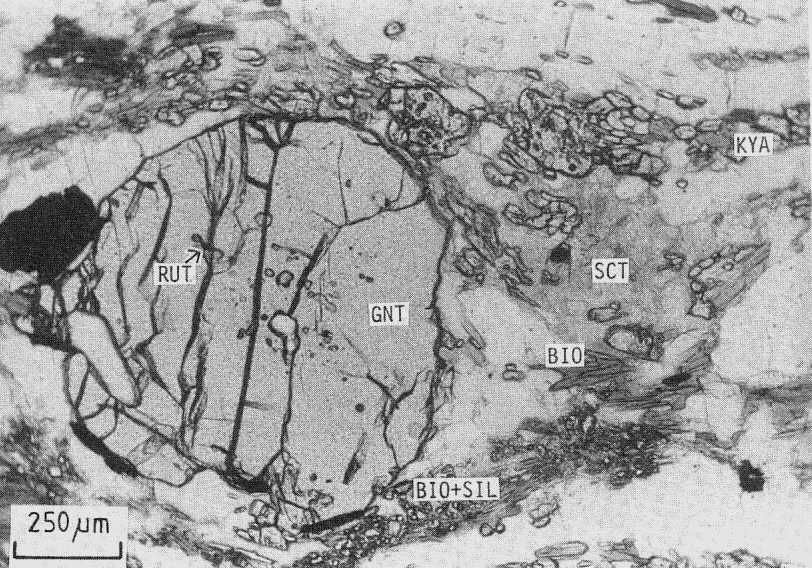
Fig. B.3.6: Garnet-Al2SiO5-biotite gneiss. Large garnet
with central inclusions, surrounded by a sillimanite - biotite aggregate (BIO+SIL)
and small grains of disintegrated kyanite (KYA). GNT = garnet, BIO = biotite,
RUT = rutile, SCT = sericitic substance.
(Thin section 100B2d, 554,2 m, // nicols).
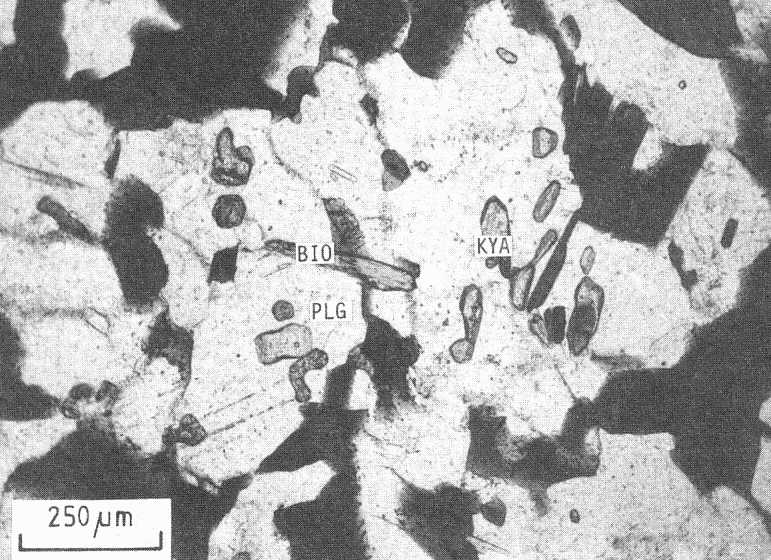
Fig. B.3.7: Garnet-Al2SiO5-biotite gneiss. Relictic
kyanite grains (KYA) within plagioclase (PLG). BIO = biotite.
(Thin section 382B1e, 1730.2 m, // nicols).
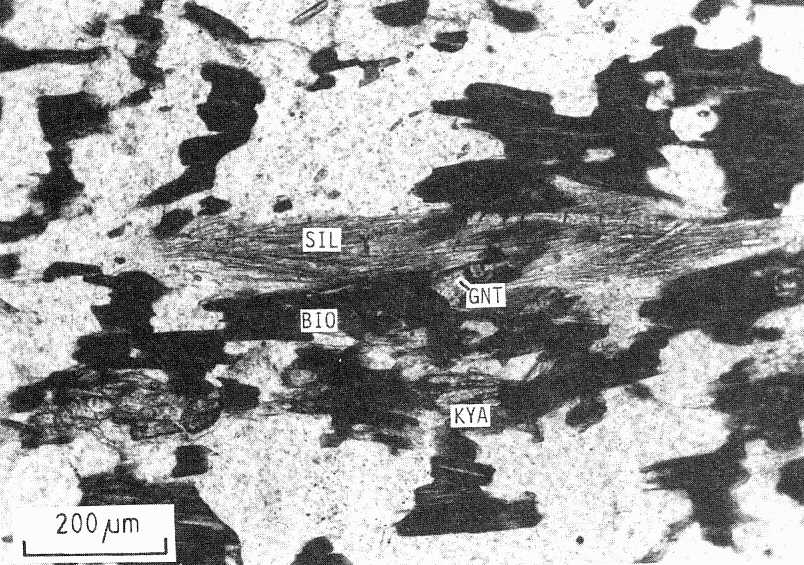
Fig. B.3.8: Garnet-Al2SiO5-biotite gneiss. Sillimanite
(SIL) and kyanite (KYA) have phase boundaries to biotite (BIO), but not to
themselves. GNT = garnet.
(Thin section 447E2q, 1979.2 m, // nicols).
Biotite-hornblende gneisses:
Biotite-hornblende gneisses occur as small interlayers within the Al2SiO5-bearing gneisses but mainly as part of the variegated sequences together with amphibolites and calcsilicate rocks (0 to 460 m and 2470 to 2580 m).
Main constituents of these gneisses are plagioclase, biotite, hornblende, quartz and in places cummingtonite and microcline. The early high-pressure / high-temperature stage is documented by the relictic paragenesis of clinopyroxene+garnet+quartz together with mesoperthites (Fig. B.3.9, B.3.10).
Fig. B.3.9: Clinopyroxene-garnet-hornblende-biotite gneiss. Clinopyroxene
(CPX) with inclusion of garnet (GNT) is surrounded by a corona of amphibole-plagioclase
symplectite (SYM). QRZ = quartz, TIT = titanite.
(Thin section 619E1gk, 2547,1 m, // nicols).
Fig. B.3.10: Hornblende-biotite augengneiss with mesoperthite (MEP).
(Thin section CUT3846, 3846 m, + nicols).
Accessory minerals are zircon, monazite, allanite, titanite, and apatite. Allanite-bearing gneisses are bound to the neighbourhood of amphibolites.
Saussuritization and sericitization of feldspar and chloritization of biotite and hornblende are widespread.
Some biotite-hornblende gneisses bear plagioclase porphyroclasts of 1 - 5 mm diameter with small inclusions of droplike strain free quartz. At 2480 to 2490 m these porphyroclasts have an isometric shape; in general they are elliptically elongated parallel to the foliation.
Other gneiss-types occurring in subordinate amounts:
From 3420 to 3440 m leucocratic biotite gneisses occur. Granular plagioclase defines a weak foliation (Fig. B.3.11).
Fig. B.3.11: Leucocratic garnet-biotite gneiss with granular fabric.
(Core piece 837E1mK, 3427.0 m, scale in cm).
Below 3773 m within the metabasites some augengneisses are intercalated. They contain various amounts of hornblende and/or biotite and/or garnet. The marginally or totally recrystallized plagioclase porphyroclasts reach 1 cm diameter normal to foliation and lineation (Fig. B.3.12). Fine grained mesoperthite, microcline and plagioclase occur in the matrix.
Fig. B.3.12: Augengneiss, a) normal to the lineation, b) parallel to the
lineation.
(Core piece 922A1b, 3776 m, core diameter 9.4 cm).
B.3.2 Chemical composition
The chemical composition of the garnet-Al2SiO5-muscovite-biotite gneisses (Table B.3.1) correspond to the composition of greywackes, clayey greywackes and claystones, judging from the SiO2/Al2O3 versus K2O/Na2O diagram after Wimmenauer (1984, Fig B.3.13). Greywackeceous compositions predominate, claystone compositions are subordinate. The greywacke/claystone interlayering could be the result of a flysch like sedimentation process. The biotite-hornblende gneisses as well as the leucocratic garnet-biotite gneisses appear interlayered with the meta-greywackes. The composition of those hornblende-bearing gneisses is compatible with that of CaO-rich greywackes.
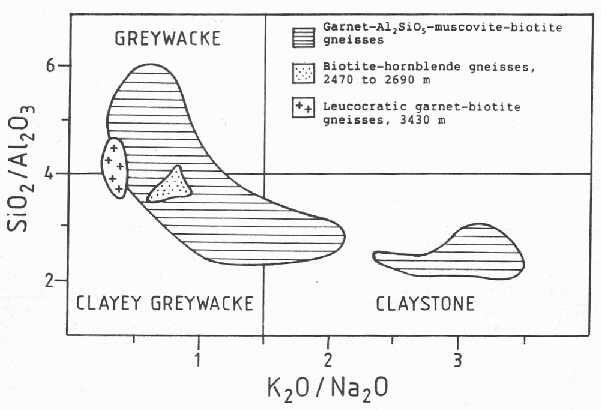
Fig. B.3.13: Plot of chemical analyses of different gneisses into the SiO2/Al2O3 versus K2O/Na2O diagram with the field of different clastic sediments after Wimmenauer (1984).
Table B.3.1: Selected chemical (XRF) and modal (XRD) analyses of the main rock types. Main constituents and modal amounts in wt.-%, trace elements in ppm. The detection limit of quantitative XRD is 1 to 3 wt.-%.
